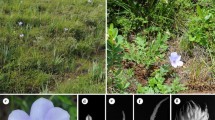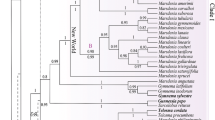Abstract
Tectariaceae are a pantropical fern family of about 20 genera, among which 8 are distributed in China. The morphological distinctiveness of the family is widely recognized, yet relatively little systematic research has been conducted on members of Tectariaceae. Phylogenetic analyses of chloroplast DNA sequence data (rbcL and atpB) from 15 species representing all 8 genera in China were carried out under parsimony criteria and Bayesian inference. The phylogenetic reconstructions indicated that the fern family Tectariaceae as traditionally circumscribed are polyphyletic. Ctenitis, Dryopsis, Lastreopsis clustered with and should be included within the newly-defined Dryopteridaceae, and Pleocnemia is also tentatively assigned to it. A narrowly monophyletic Tectariaceae is identified, which includes Ctenitopsis, Hemigramma, Pteridrys, Quercifilix, and Tectaria. In the single rbcL analysis, Arthropteris clustered with the above-mentioned monophyletic Tectariaceae. Although further investigations are still needed to identify infrafamilial relationships within the monophyletic Tectariaceae and to redefine several problematic genera, we propose a working concept here that better reflects the inferred evolutionary history of this group.
Similar content being viewed by others
References
Wang C H. A taxonomical study of the family Aspidiaceae from the mainland of Asia. Acta Phytotax Sin (in Chinese), 1965, 10(2): 121–129
Wang C H, Wu S H. Flora Reipublicae Popularis Sinicae (in Chinese). Beijing: Science Press, 1999. 1–103
Ching R C. On natural classification of the family “Polypodiaceae”. Sunyatsenia, 1940, 5: 201–268
Holttum R E. A revised classification of leptosporangiate ferns. Bot J Linn Soc, 1947, 53: 123–158, 10.1111/j.1095-8339.1947.tb02554.x
Nayar B K. A phylogenetic classification of the homosporous ferns. Taxon, 1970, 19: 229–236, 10.2307/1217958
Kramer K U, Holttum R E, Moran R C, et al. Dryopteridaceae. In: Kubitzki K, ed. The Families and Genera of Vascular Plants. Vol 1. Pteridophytes and Gymnosperms. Berlin: Springer, 1990. 101–144
Pichi Sermolli R E G. Tentamen pteridophytorum genera in taxonomicum ordinem redigendi. Webbia, 1977, 31: 313–512
Tryon R M, Tryon A F. Ferns and Allied Plants, with Special Reference to Tropical America. New York: Springer, 1982
Ching R C. The Chinese fern families and genera: systematic arrangement and historical origin. Acta Phytotax Sin (in Chinese), 1978, 16(3): 1–19; 16(4): 16-37
Hasebe M, Wolf P G, Pryer K M, et al. Fern phylogeny based on rbcL nucleotide sequences. Am Fern J, 1995, 85: 134–181, 10.2307/1547807
Pryer K M, Smith A R, Skog J E. Phylogenetic relationships of extant ferns based on evidence from morphology and rbcL sequences. Am Fern J, 1995, 85: 205–282, 10.2307/1547810
Pryer K M, Schneider H, Smith A R, et al. Horsetails and ferns are a monophyletic group and the closest living relatives to seed plants. Nature, 2001, 409: 618–622, 11214320, 10.1038/35054555, 1:STN:280:DC%2BD3M7islSntw%3D%3D
Li C X, Lu S G. Phylogenetic analysis of Dryopteridaceae based on chloroplast rbcL sequences. Acta Phytotax Sin (in Chinese), 2006, 44(5): 503–515, 10.1360/aps050081
Liu H M, Zhang X C, Chen Z D, et al. Inclusion of the eastern Asia endemic genus Sorolepidium in Polystichum (Dryopteridaceae): Evidence from the chloroplast rbcL gene and morphological characteristics. Chin Sci Bull, 2007, 52: 631–638, 10.1007/s11434-007-0115-2, 1:CAS:528:DC%2BD2sXisV2nsrg%3D
Lu J M, Li D Z. The study on systematic position of Cyclopeltis. Acta Bot Yunnan (in Chinese), 2006, 28(4): 337–340, 1:CAS:528:DC%2BD2sXhtlCitL7O
Smith A R, Pryer K M, Schuettpelz E, et al. A classification for extant ferns. Taxon, 2006, 56(3): 705–731, 10.2307/25065646
Doyle J, Doyle J. A rapid DNA isolation procedure for small quantities of fresh leaf tissue. Phytochem Bull, 1987, 19: 11–15
Chen Z D, Wang X Q, Sun H Y, et al. Systematic position of the Rhoipteleaceae: Evidence from nucleotide sequences of the rbcL gene. Acta Phytotax Sin (in Chinese), 1998, 36: 1–7
Gastony G J, Rollo D R. Phylogeny and generic circumscriptions of cheilanthoid ferns (Pteridaceae: Cheilanthoideae) inferred from rbcL nucleotide sequences. Am Fern J, 1995, 85: 341–360, 10.2307/1547814
Thompson J D, Gibson T J, Plewniak F, et al. The Clustal X windows interface: Flexible strategies for multiple sequence alignment aided by quality analysis tools. Nucleic Acids Res, 1997, 24: 4876–4882, 10.1093/nar/25.24.4876
Swofford D L. PAUP* 40: Phylogenetic analysis using parsimony (*and other methods), Version 40b10. Sunderland: Sinauer Associates, 2003
Ronquist F, Huelsenbeck J P. MrBayes 3: Bayesian phylogenetic inference under mixed models. Bioinformatics, 2003, 19: 1572–1574, 12912839, 10.1093/bioinformatics/btg180, 1:CAS:528:DC%2BD3sXntlKms7k%3D
Posada D, Crandall K A. Modeltest: testing the model of DNA substitution. Bioinformatics, 1998, 14: 817–818, 9918953, 10.1093/bioinformatics/14.9.817, 1:CAS:528:DyaK1MXktlCltw%3D%3D
Felsenstein J. Confidence limits on phylogenies: An approach using the bootstrap. Evolution, 1985, 39: 783–791, 10.2307/2408678
Christensen C. Manual of Pteridology. Waltham, Massachusetts: The Chronica Botanica Company, 1938
Wu S H, Ching R C. Fern Families and Genera of China (in Chinese). Beijing: Science Press, 1991
Holttum R E, Edwards P J. Studies in the fern genera allied to Tectaria II. Dryopsis, a new genus. Kew Bull, 1986, 41: 171–204
Widén C J, Fraser-Jenkins C R, Reichstein T, et al. A survey of phenolic compounds in Dryopteris and related fern genera. Part III. Ann Bot Fennici, 2001, 38: 99–138
Dong S Y, Lu S G. Classification of the genus Dryopsis (Tectariaceae) from Yunnan. Acta Bot Yunnan (in Chinese), 2001, 23: 181–187
Holttum R E. The fern-genus Pleocnemia. Kew Bull, 1974, 29: 341–357
Tryon A F, Lugardon B. Spores of the Pteridophyta. New York: Springer-Verlag, 1991
Sledge W A. The tectarioid ferns of Ceylon. Kew Bull, 1972, 27: 407–424
Price M G. Nine new fern names. Kalikasan Philip J Biol, 1974, 3: 173–178
Copeland E B. Genera Filicum. Waltham, Massachusetts: Chronia Botanica Company, 1947. 1–247
Holttum R E. The genus Heterogonium Presl. Kalikasan Philip J Biol, 1975, 4: 205–231
Ching R C. A revision of the Chinese and Sikkim-Himalayan Dryopteris with reference to some species from neighbouring regions. Bull Fan Mem Inst Biol Bot Ser, 1938, 8(5): 304
Kramer K U. Oleandraceae. In: Kubitzki K, ed. The Families and Genera of Vascular Plants. Vol 1. Pteridophytes and Gymnosperms. Berlin: Springer, 1990. 190–193
Author information
Authors and Affiliations
Corresponding authors
Additional information
Supported by the National Natural Science Foundation of China (Nos. 30121003 and 30228004), National Basic Research Program of China (973 Program No. 2007CB411600) and Wong Kuan Chung Education Foundation of Hong Kong
Rights and permissions
About this article
Cite this article
Liu, H., Zhang, X., Chen, Z. et al. Polyphyly of the fern family Tectariaceae sensu Ching: insights from cpDNA sequence data. SCI CHINA SER C 50, 789–798 (2007). https://doi.org/10.1007/s11427-007-0099-9
Received:
Accepted:
Published:
Issue Date:
DOI: https://doi.org/10.1007/s11427-007-0099-9




